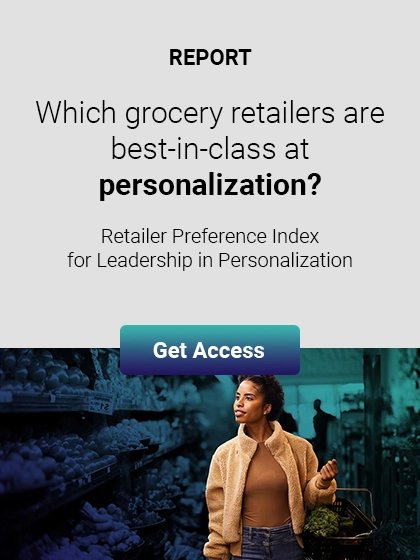Retail Media in a Post-Cookie World
Retailers are uniquely placed to help brands connect with their consumers. Those who prepare now will see exponential growth in media revenue.
Google recently confirmed their intention to block third-party cookies from Chrome. With the browser used by nearly two thirds of internet users, this will make life more difficult for advertisers looking to deliver targeted, measurable digital media campaigns; however, it also creates an opportunity for retailers to secure their position as a vital media partner for brands.
From 2022, Google looks likely to limit the extent to which advertisers can use current advertising mechanisms, including retargeting, attribution and frequency capping. Google-controlled solutions such as Federated Learning of Cohorts (FLoC) seem to offer advertisers limited transparency or flexibility in their targeting strategy, though the industry is still awaiting enough detail to fully understand the impact of these ‘privacy sandbox’ applications. Similarly, there is ambiguity around whether alternate identity solutions will continue to function. Despite the lack of clarity, there is a general consensus that advertisers will have less flexibility, precision and control in their digital media executions by early 2022.
This will have a polarising effect on media owners. When users are logged in to publisher properties, advertisers will retain some of the targeting and measurement functionality that they rely on today. This means that while smaller publishers can expect revenues to diminish, larger publishers with a critical mass of logged-in users will be able to build a differentiated value proposition and a corresponding increase in demand.
Retailers as digital publishers
Retailers are uniquely positioned to benefit from the changing dynamics of the digital media ecosystem. The surge in e-commerce as a result of the pandemic has turned many retailers into sizeable digital publishers. Today, they can offer brands a powerful combination of contextual targeting, based on merchandise categories, products and searches, together with audience targeting based on historical transaction history. Where retailers monetise media to their own suppliers, they can attribute exposure to sale and analyse the impact of investment on incremental revenue and long-term loyalty. This is already a powerful proposition, estimated to represent a $15-20B opportunity for CPG retailers in the US alone¹, and one that will scale further as retailers’ ecommerce footprints continue to grow.
In 2022, the death of the cookie will create a lever for the exponential growth of retail media. Retailers enjoy anomalously high log-in rates compared to other publishers, and this will enable them to continue delivering valuable, scalable targeting and measurement to brands as the cookie disappears. As other publishers struggle to support even more basic digital advertising use cases, the relative value of retailers’ inventory will soar, driving an influx of investment.
In addition to monetising their own ‘Onsite’ inventory, many retailers offer ‘Digital Offsite’ propositions. These enable brands to target, measure and optimise campaigns using retailer data sets, activated across third-party media.
Here, Google’s changes will create some challenges for retailers. Today, cookies render the open web a fairly unified space. Next year, there will be significant fragmentation, even for advertisers accessing first-party retailer data sets. Google tells us that they “will continue to support first-party relationships on our ad platforms for partners, in which they have direct connections with their own customers”, but there is little detail on how this will work in practice.
The most likely outcome is that advertisers with first-party data can use it to buy targeted impressions across publishers who hold the same data from logged-in users. This will require retailers, or the advertisers who use their data, to build direct relationships with publishers and move from delivering unified campaigns across wide networks of sites to fragmented activations brokered with individual publishers. Any post-cookie first-party identity solutions that Chrome continues to permit may help reduce these challenges by providing a single integration point for multiple publishers, but operational complexity will still increase as scale decreases.
Retailer opportunities
Beyond the open web, walled garden environments (Facebook, YouTube, Snap etc.) plus emerging channels like Connected TV (CTV) will be unaffected by Google’s changes. These platforms typically provide strong match rates against retailer data sets and the scale to deliver meaningful campaigns for advertisers, providing alternative and increasingly scalable channels for retailer data activation.
In the mid-term then, there will be plenty of opportunities for Offsite data monetisation, but these will require mature retail media teams with the skills, knowledge and relationships to navigate the complexity of a more fragmented ecosystem. As with Onsite, Offsite media will benefit from a relative increase in value as brands’ ability to target and measure non-retail media is diminished. Retailers who invest now in building solutions that are sustainable in a post-cookie world can also expect to see an exponential growth in Offsite investment next year.
For retailers who invest in building their media propositions, the close sequencing of a surge in ecommerce plus the demise of third-party cookies will create a significant opportunity for high-margin revenue growth. While several retailers have already made a notable success of their media monetisation programmes, for most brands retail media remains just a small part of their overall investment strategy. Next year, this looks likely to change, giving retailers the opportunity to become the dominant premium publishers and data providers in a post-cookie world.
¹Goldman Sachs, Consumer Staples The Merchant-Media Model
The latest insights from our experts around the world
AI's Regulatory Crossroads: Innovation vs. Control
Why you need a demand model
AI: three breakout applications for consumer brands

Speak to a member of our team for more information



